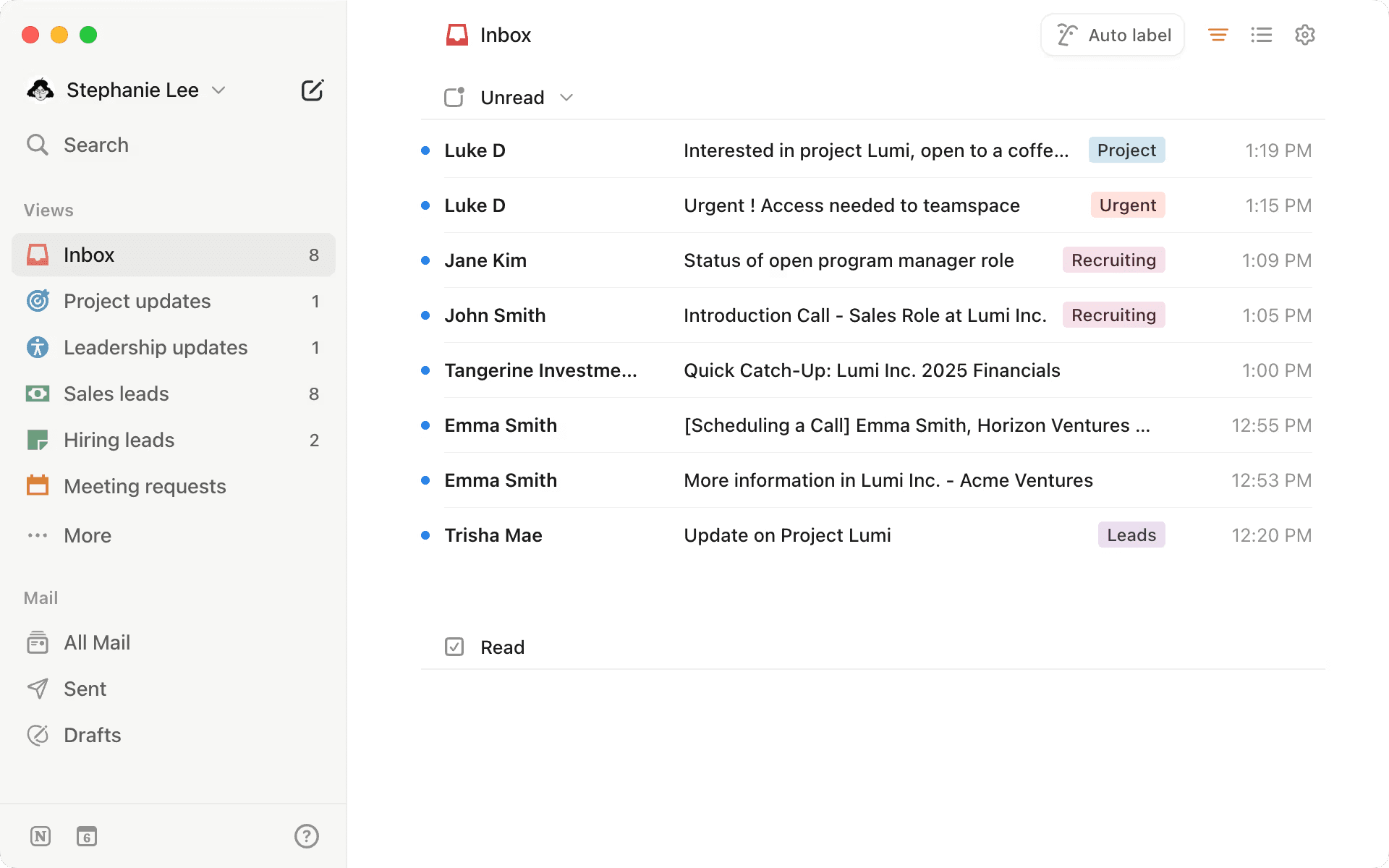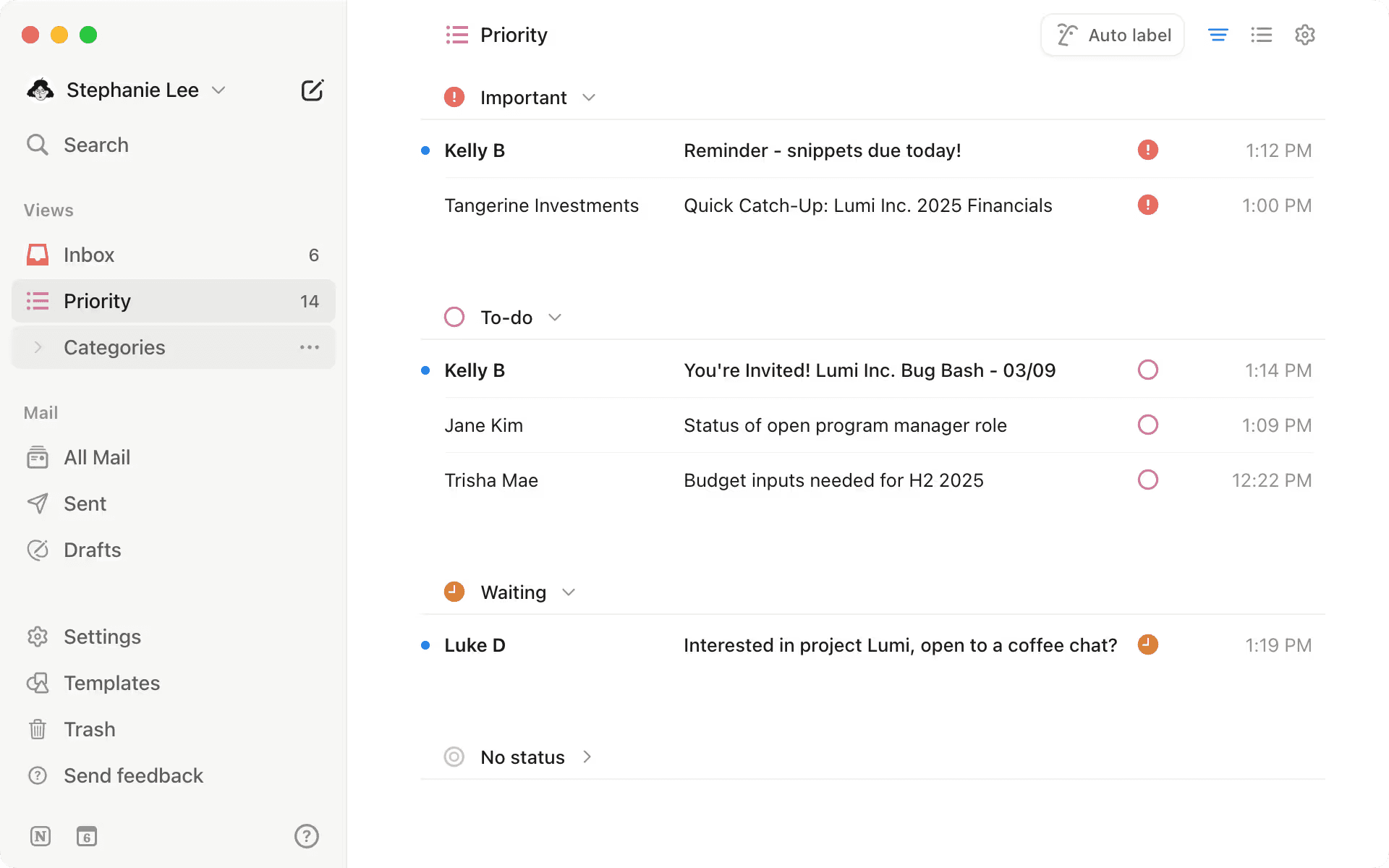Proton Mail vs. Gmail: A detailed comparison
For many people who use email daily, Gmail is the go-to choice for its helpful features and integrations. Proton Mail, on the other hand, has emerged as a compelling alternative for users looking for email services with uncompromising privacy and security.
While both tools stand out in their respective domains, users often discover they’re not always comprehensive enough. Gmail users crave alternatives that offer greater control over their workflow, while Proton Mail’s rigid emphasis on privacy usually presents limitations with features and usability.
In this article, we look closely at Proton Mail vs. Gmail, digging into their key differences to help you find which service truly fits your needs. We will answer key questions like:
What are the main differences between these email services?
How do they compare in terms of productivity and usability?
Are the offered features sufficient for your needs and workflow?
Gmail vs. Proton Mail: 5 key differences
When choosing between any two email platforms, you should look at five criteria:
User interface
Features
Storage and attachment limits
Pricing
Workflow enhancement
There are significant differences between Gmail’s and Proton Mail’s approach to these factors, as you’ll see in the below breakdowns of each.
User interface
Gmail’s simplicity is one of its main selling points. Both the web and mobile apps are intuitive and easy to navigate. The familiar design features a left-hand menu with categories and labels, which can be collapsed for a clearer overview of the inbox.
Proton Mail’s interface looks similar at first glance. Composing a new email opens a new window obstructing the inbox, which is the main complaint users have had about Gmail as well. There aren’t any significant issues besides this as all the features are laid out clearly.
One notable difference lies in the tab view above the inbox. Gmail offers three main tabs you can use to filter your mail:
Primary
Promotions
Social

Proton Mail takes a different approach, letting users choose between seeing read, unread, and emails with files.

Overall, both offer sufficient functionality for users who don’t require advanced productivity features or highly specialized workflow tools.
Features
Gmail and Proton Mail offer various features to help keep your inbox clean, search through your emails, and make emailing efficient.
As for email organization, Gmail uses categories with labels and sub-labels. You can create custom labels to associate emails with any criteria you want. You can also use multiple labels per email if they don’t fit into a single category.
The aforementioned Primary, Social, and Promotions categories rely on various algorithms to recognize which email belongs in which category and sort them appropriately, keeping your inbox neat.
Proton Mail uses similar features, except it offers labels and folders. An email can only be in one folder at a time, but it can have any number of labels. The main drawback is that the free plan only includes three folders and labels, which may not be enough if you receive a lot of mail.
Email search is another important function that Gmail makes easier. It lets you use advanced filters to find emails based on various criteria, including the following:
Labels
Subject lines
Senders
Dates
Proton Mail lets you browse emails through similar categories, but the free version lacks an important feature Gmail has—text search. You can’t search emails’ contents unless you upgrade to a paid plan, which is quite inconvenient.
Both providers also have a few time-saving features, though Gmail is more robust. It lets you set custom message alerts, schedule email sending, and snooze incoming mail. Smart Reply uses AI to suggest responses based on what you’re most likely to write back, though there have been some privacy concerns around this feature.
Storage and attachment limits
Gmail offers 15 GB of storage with the free plan. Note that the platform’s storage is shared between Gmail, Google Drive, and Google Photos, so it might fill up quite quickly if you use Drive to back up your files.
Proton Mail’s free account only includes 1 GB of storage, which is quite low. If you’re an advanced user, you might have to delete emails regularly or subscribe to one of the platform’s paid plans. Even this might not be enough as the highest tier caps the storage at 500 GB.
As for attachment sizes, both services let you upload files of up to 25 MB. Gmail will automatically turn any larger attachments into Google Drive links, so this may be a decent way to circumvent the limitation. Proton Mail does not support such an option, so you might need to zip large files before sending them.
Pricing
Gmail and Proton Mail are free to use but limited in features unless you subscribe to paid tiers. To upgrade Gmail, you can choose from four Google Workspace tiers:
Plan | Cost (with an annual commitment) |
Starter | From $7/month |
Standard | From $14/month |
Plus | From $22/month |
Enterprise | Custom |
Proton Mail offers an individual Proton Unlimited plan starting at $12.99/month, as well as three business tiers:
Plan | Cost (with a 12-month commitment) |
Mail Essentials (Businesses) | From $6.99/month |
Mail Professional | From $9.99/month |
Proton Business Suite | From $12.99 |
Gmail’s premium plans are more expensive, but they include up to 5 TB of storage, compared to Proton Mail’s aforementioned 500 GB. All Gmail’s paid plans also provide features like custom domains, video and voice conferencing, and group policy controls.
Proton Mail’s tiers also include custom domains, unlimited folders and labels, and access to Proton’s other products:
Calendar
Drive
VPN
Workflow enhancement
With email being a big part of modern work culture, you want to choose an email service that adapts to your workflow and makes task management easier.
Gmail integrates with the Google Workspace suite to provide seamless access to other work tools, including Calendar, Drive, Docs, etc. Other features like Smart Compose and Smart Reply also speed up email composition. However, even with these tools, many users have reservations—some say Gmail’s interface feels too cluttered, while others find its inbox customization features lacking for more advanced workflows.
Proton Mail has a primary focus on privacy, but when it comes to productivity, its features can feel a bit limiting. For example, the free plan only allows access to a small number of folders and labels for email management. Key features like auto-forwarding and auto-deleting are also restricted to the paid plan. So, if you juggle a lot of work, Proton Mail may not offer the flexibility or efficiency to streamline your workflow.
While Gmail and Proton Mail offer fundamental tools, modern productivity demands smarter automation and deeper workflow integration. Newer email solutions are built to automate repetitive tasks, adapt to unique priorities, and even turn emails into actionable workflows—all without manual setup.
For users seeking email experiences centered around workflow productivity, Notion Mail offers a fresh approach worth exploring. It places workflow optimization at the core of its user experience, bridging the gap between inbox organization and task management.
How Notion Mail enhances your workflow

Notion Mail is an AI-native email provider that delivers AI assistance and customizability, allowing you to tailor your email experience according to your needs and preferences. The tool is designed to make your email work for you, with powerful features that simplify your daily tasks.
Notion Mail focuses on enhancing your workflow by providing:
AI-powered automation: Allow AI to take the reins for less important work using AI autopilot. It automatically labels and prioritizes relevant emails so you can focus on tackling real, serious work.
Customizable views: Modify your inbox until it looks exactly how you want it for different projects, clients, and priorities. You no longer have to sift through email junk to find what you need.
Seamless Notion integration: Connect your email directly to your Notion workspace for seamless collaboration. Link emails to documents, databases, projects, etc., for a unified workflow.
Quick replies and snippets: Rely on Notion Mail’s built-in quick replies that adapt to you or your organization’s needs, and let its reusable email snippets (AI-supported templates) help you create personalized emails in a few clicks.

Notion Mail also focuses on ease of use, which is why it sports a clean and intuitive user interface that you can easily navigate, even if you’re not tech-inclined. All your productivity features are user-friendly, so you can jump on important tasks right away.
Boost your productivity with Notion Mail’s integrated suite
Notion Mail allows you to integrate with the full Notion suite, starting with Notion Calendar—a free tool that seamlessly syncs with your inbox to simplify scheduling and avoid meeting clashes. With the /schedule command, you can insert a scheduling button like Calendly in one click, allowing recipients to pick a slot directly in your calendar—no back-and-forth.
To get started with Notion Mail, visit the Notion Mail signup page and connect your Google or Gmail account. You immediately get access to productivity features and some pretty advanced AI tools. If you want even further automation or customization, try the Notion AI add-on.
Bonus read: Need more insight on popular email platforms and how they compare? Our expert guides below cover comparisons, breakdowns, and alternatives:
